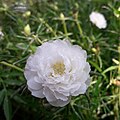bio.wikisort.org - Plant
Portulaca grandiflora is a succulent flowering plant in the family Portulacaceae, native to southern Brazil, Argentina, and Uruguay and often cultivated in gardens.[2][3] It has many common names, including rose moss,[4] eleven o'clock,[3] Mexican rose,[3] moss rose,[3] sun rose,[5] rock rose,[5] and moss-rose purslane.
| Portulaca grandiflora | |
|---|---|
 | |
| Scientific classification | |
| Kingdom: | Plantae |
| Clade: | Tracheophytes |
| Clade: | Angiosperms |
| Clade: | Eudicots |
| Order: | Caryophyllales |
| Family: | Portulacaceae |
| Genus: | Portulaca |
| Species: | P. grandiflora |
| Binomial name | |
| Portulaca grandiflora | |
| Synonyms[1] | |
| |

It is also seen in South Asia and widely spread in most of the cities with old 18th- and 19th-century architecture in the Balkans.
Description
It is a small, but fast-growing annual plant growing to 30 cm tall, though usually less. However, if it is cultivated properly, it can easily reach this height. The leaves are thick and fleshy, up to 2.5 cm long, arranged alternately or in small clusters. The flowers are 2.5–3 cm diameter with five petals, variably red, orange, pink, white, and yellow.[2] Their upright, or ascending, long shoots branch usually near the base. The spreading 20 to 25 millimeters long and 2 to 3 millimeters wide leaves are almost or completely stalk-shaped and taper towards the tip.
The axillary have few to numerous, whitish, woolly hair, which are usually shorter than the sheets. The compressed inflorescences are surrounded by eight to ten leaves. The large flowers reach a diameter of up to 4 centimetres. The five bright magenta-coloured petals are obovate and 15 to 26 millimeters long. Around the ovary with four to nine whitish scars are about 50 stamens. Capsules and seeds are not visible.[6]
P. grandiflora is one of the few plants that is a C4/CAM intermediate, utilizing both C4 carbon fixation and Crassulacean acid metabolism pathways in different cells for photosynthesis.[7]
Cultivation and uses
Numerous cultivars have been selected for double flowers with additional petals, and for variation in flower colour, plain or variegated.[2] It is widely grown in temperate climates as an ornamental plant for annual bedding or as a container plant. It requires ample sunlight and well-drained soils. It requires almost no attention and spreads itself very easily. In places with old architecture it can grow between the stones of the road or sidewalk. Seeds are often sold as mixtures, such as Double Flowering Mixture (see illustrations). It grows on sandy soils. In countries with a frost-free climate, it is wild.[8][9]
Unlike P. oleracea and P. umbraticola , it is not edible because of its bitter taste. There are hybrids of P. grandiflora with P. oleracea, umbraticola and villosa.
It is visited by honeybees for its pollen and nectar.[10]
Gallery
- Portulaca Grandiflora in India
- Portulaca Grandiflora bicolour
- Portulaca grandiflora in India
- Portulaca grandiflora in India, which is in a tob
- Traditional Brazilian sort of Portulaca grandiflora
- Portulaca grandiflora double flower variety
- Mixed Portulaca grandiflora growth
- Portulaca Grandiflora white variety in Pakistan
- Single leaves.
- Portulaca grandiflora. 2018 Taichung World Flora Exposition, Taiwan.
- Cultivar with double flowers
References
- "The Plant List: A Working List of All Plant Species". Retrieved 21 June 2015.
- Huxley, A., ed. (1992). New RHS Dictionary of Gardening. Macmillan ISBN 0-333-47494-5.
- "Portulaca grandiflora". Germplasm Resources Information Network (GRIN). Agricultural Research Service (ARS), United States Department of Agriculture (USDA). Retrieved 10 January 2018.
- USDA, NRCS (n.d.). "Portulaca grandiflora". The PLANTS Database (plants.usda.gov). Greensboro, North Carolina: National Plant Data Team. Retrieved 31 January 2016.
- Mitchell, H. (2003). The Essential Earthman: Henry Mitchell on Gardening. Indiana University Press. p. 113. ISBN 9780253215857.
- Urs Eggli (ed.): Succulent Encyclopedia. Dicots (dicotyledons) . Eugen Ulmer, Stuttgart 2001, ISBN 3-8001-3662-7 , pp. 437-438 .
- Guralnick, Lonnie; Gilbert, Kate; Denio, Diana; Antico, Nicholas (2020-01-01). "The Development of Crassulacean Acid Metabolism (CAM) Photosynthesis in Cotyledons of the C4 Species, Portulaca grandiflora (Portulacaceae)". Plants. 9 (1): 55. doi:10.3390/plants9010055. PMC 7020464. PMID 31906418.
- Blumea. Tijdschrift voor de Systematiek en Geography of the Plants . Volume 17, No. 2, p. 297, Leiden 1969
- Botanical Magazine; or, Flower-Garden Displayed . Volume 56, Plate 2885. London 1829
- "Portulaca grandiflora & Apis mellifera". Florabeilles (in French). 2012-09-09. Retrieved 2019-07-08.
На других языках
- [en] Portulaca grandiflora
[es] Portulaca grandiflora
Portulaca grandiflora, conocida como mañanitas, amor de un rato, flor de seda, bella a las once o verdolaga de flor es una planta anual suculenta de la familia Portulacaceae.Другой контент может иметь иную лицензию. Перед использованием материалов сайта WikiSort.org внимательно изучите правила лицензирования конкретных элементов наполнения сайта.
WikiSort.org - проект по пересортировке и дополнению контента Википедии










